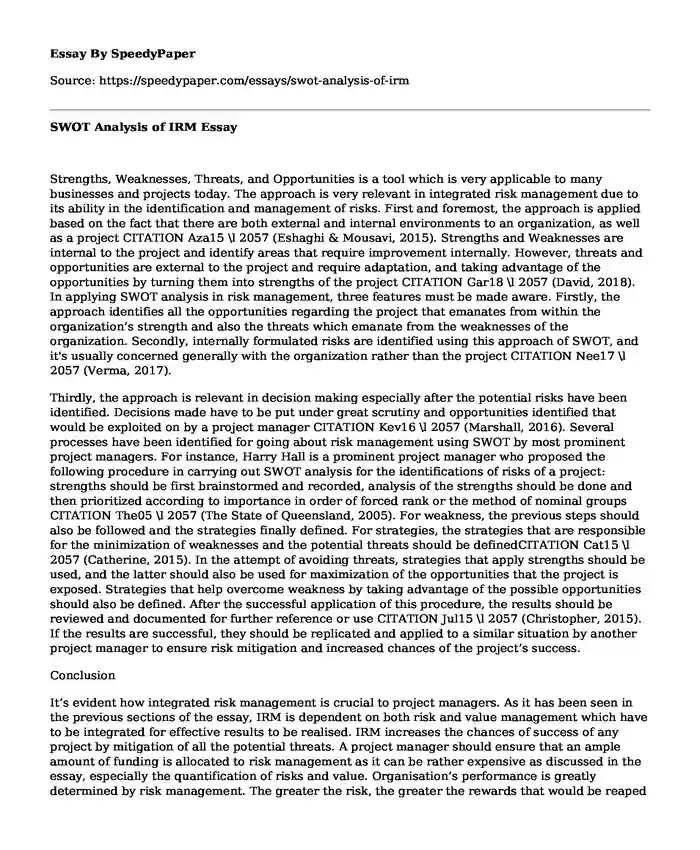Strengths, Weaknesses, Threats, and Opportunities is a tool which is very applicable to many businesses and projects today. The approach is very relevant in integrated risk management due to its ability in the identification and management of risks. First and foremost, the approach is applied based on the fact that there are both external and internal environments to an organization, as well as a project CITATION Aza15 \l 2057 (Eshaghi & Mousavi, 2015). Strengths and Weaknesses are internal to the project and identify areas that require improvement internally. However, threats and opportunities are external to the project and require adaptation, and taking advantage of the opportunities by turning them into strengths of the project CITATION Gar18 \l 2057 (David, 2018). In applying SWOT analysis in risk management, three features must be made aware. Firstly, the approach identifies all the opportunities regarding the project that emanates from within the organization's strength and also the threats which emanate from the weaknesses of the organization. Secondly, internally formulated risks are identified using this approach of SWOT, and it's usually concerned generally with the organization rather than the project CITATION Nee17 \l 2057 (Verma, 2017).
Thirdly, the approach is relevant in decision making especially after the potential risks have been identified. Decisions made have to be put under great scrutiny and opportunities identified that would be exploited on by a project manager CITATION Kev16 \l 2057 (Marshall, 2016). Several processes have been identified for going about risk management using SWOT by most prominent project managers. For instance, Harry Hall is a prominent project manager who proposed the following procedure in carrying out SWOT analysis for the identifications of risks of a project: strengths should be first brainstormed and recorded, analysis of the strengths should be done and then prioritized according to importance in order of forced rank or the method of nominal groups CITATION The05 \l 2057 (The State of Queensland, 2005). For weakness, the previous steps should also be followed and the strategies finally defined. For strategies, the strategies that are responsible for the minimization of weaknesses and the potential threats should be definedCITATION Cat15 \l 2057 (Catherine, 2015). In the attempt of avoiding threats, strategies that apply strengths should be used, and the latter should also be used for maximization of the opportunities that the project is exposed. Strategies that help overcome weakness by taking advantage of the possible opportunities should also be defined. After the successful application of this procedure, the results should be reviewed and documented for further reference or use CITATION Jul15 \l 2057 (Christopher, 2015). If the results are successful, they should be replicated and applied to a similar situation by another project manager to ensure risk mitigation and increased chances of the project's success.
Conclusion
It's evident how integrated risk management is crucial to project managers. As it has been seen in the previous sections of the essay, IRM is dependent on both risk and value management which have to be integrated for effective results to be realised. IRM increases the chances of success of any project by mitigation of all the potential threats. A project manager should ensure that an ample amount of funding is allocated to risk management as it can be rather expensive as discussed in the essay, especially the quantification of risks and value. Organisation's performance is greatly determined by risk management. The greater the risk, the greater the rewards that would be reaped from the undertaken project, unless risk management is applied successfully. Hence IRM is a key determinant of organisation's performance. However, despite their expensive nature, the results are worthy, and there is a great chance of finishing a project according to the specifications of the stakeholders. SWOT analysis has also been seen to be very crucial in IRM. Instead of just listing strengths, weaknesses, opportunities or threats of a project, they should be applied as a matrix, where strengths are listed as either threat or opportunity, same as the weaknesses.
References
BIBLIOGRAPHY Bassiony, M. S., 2015. Identification and assessment of risk factors affecting construction projec...
Cite this page
SWOT Analysis of IRM. (2022, Dec 09). Retrieved from https://speedypaper.net/essays/swot-analysis-of-irm
Request Removal
If you are the original author of this essay and no longer wish to have it published on the SpeedyPaper website, please click below to request its removal:
- Free Essay Sample on Feminism and Jane Austen
- Religion Essay Sample: North and South Religion Research
- Essay Example on the Lewin's Change Management Model
- Essay Sample Analyzing Douglas Cope's The Limits of Racial Domination
- Essay Sample on European Imperialism in Africa
- Essay Sample on a Modern Drama Play by Brian Friel
- Essay Sample on McDonald's Stock Management System
Popular categories





